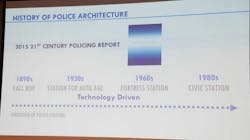The evolution of design in police stations has come a long way in just the last few decades, mirroring modern approaches to law enforcement and engagement with the community.
Gary DeVries, Ray Holliday and Fred Clifford with Brown Reynolds Watford Architects (link: https://www.firehouse.com/stations/architects/company/12141215/fire-station-architect-firm-brw-architects-firehouse-designers) spoke to Station Design Conference attendees about some modern approaches to designing a new or renovated police station that maintain functionality and safety while showing the public an approachable look and feel.
Some key goals for 21st Century policing can be achieved with the help of your station design:
Simultaneously promoting crime reduction and building the public trust
Serving within operational budget constraints.
BRW’s veteran architects first walked session attendees through how much has changed in the design of police stations since they first became part of our communities in the 1850s.
For example, in the 1930s police stations had to begin accommodating the auto industry boom, which in turn created the first rolling patrols after officers primarily worked their tours on foot or horseback.
It was a few decades later in the 1960s that police stations took on a fortress-like feel with no windows and a blocked-out look that was meant to convey strength and power.
That approach is the exact opposite of what we’ve seen in police station design starting around the 1980s and really taking a leap forward around the year 2,000.
Newer designs offer a literal transparency with plenty of safety glass surrounding many structures, providing a sense of welcome and engagement for members of the community who have business to conduct with their local police.
Civic-minded stations also maintain an open feel in their public spaces, which are beginning to contain things such as memorial spaces for those who have fallen in the line of duty along with soft touches such as gardens and outdoor break spaces to aid with stress reduction.
The more secure interiors of modern stations are also addressing modern concerns with how their zones are situated given how critical it is to maintain separation of critical activities involving the public, staff, victims, witnesses and offenders.
The main points you should try to hit in your design projects will balance operational demands, budgets and civic pride, which provides several benefits:
Increased connection with the community
Better integrated technology
More flexible, healthier and stress-reducing work environments
More secure and resilient facilities
Taking into account how your police department wants to engage with the community when making critical design choices can benefit not just the public but your officers as well.



